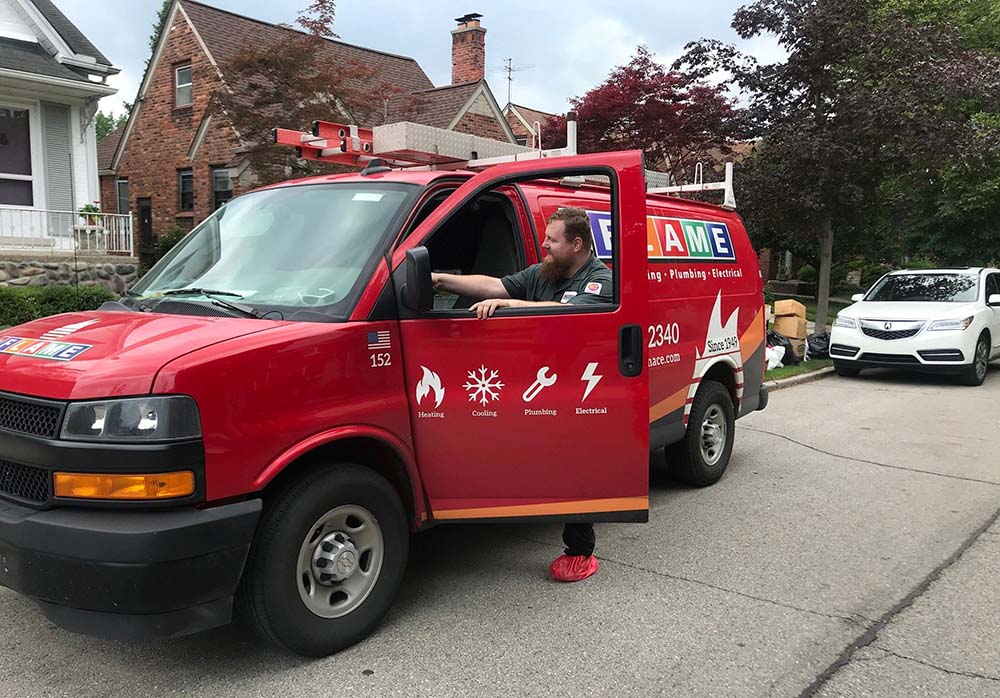Since the COVID-19 pandemic struck nearly three years ago, automobile manufacturers have had trouble getting many of the parts — computer chips especially — required to assemble the vans and trucks that field-service businesses use daily. Delays of a year in obtaining new vehicles for service fleets are common.

LONG AND WINDING ROAD: Nearly three years after the coronavirus pandemic disrupted supply chains and caused shortages of automobile parts, particularly computer chips, at vehicle manufacturers, HVACR contractors are still facing delays in obtaining new trucks and vans for their fleets. (Courtesy of Service Legends)
HVACR contractors, tired of playing the waiting game, have gotten creative in order to keep enough vehicles on the road, lengthening replacement cycles, buying used trucks and vans as stop-gaps, and settling for the models they can get rather than the models they want.
“They’re not making them fast enough,” said Gary Marowske, president of Flame Heating, Cooling, Plumbing and Electrical in Warren, Michigan.

SUPPLY AND DEMAND: A Flame Heating, Cooling, Plumbing and Electrical technician with a company service van. President Gary Marowske said the company didn’t replace any service vehicles this year because of the difficulty in obtaining new ones, even though between 15 and 20 vehicles were due to be replaced. The few new ones it could get, he said, were simply added to the fleet to accommodate growth. (Courtesy of Flame Heating, Cooling, Plumbing and Electrical)
Marowske, whose fleet at Flame numbers around 100, was scheduled to replace between 15 and 20 vehicles this year, but ended up replacing none.
“We couldn’t afford to get rid of any because we couldn’t get a replacement,” Marowske said in early November.
The few new vehicles he could buy went toward company growth rather than replacement, he added.
“We needed half a dozen service vans 18 months ago and we just got them in June,” said Brian Leech, owner and CEO of Service Legends Inc. in Des Moines, Iowa.
The Service Legends fleet totals around 40. Recently, the company has gone to the pre-owned market, and also taken delivery of models that weren’t at the top of its list, in order to keep getting technicians to job sites, Leech said.
“I had to have four vans on the road within 30 days — otherwise, the technicians would just be standing around,” Leech said.
At General Motors Corp., the only Big Three automaker to respond to ACHR NEWS inquiries about the state of work vehicle manufacturing, the overall situation has recently gotten better, a spokesman said.
“We have seen improvements and better consistency in the supply chain through the third quarter this year compared to last year as a whole,” said Sabin D. Blake, director of North American business communications for GM.
That has translated into production and vehicle-delivery improvements and led to third-quarter sales that were higher than in 2021, Blake added. (GM reported selling 555,580 vehicles in the U.S. in the third quarter, up 24% from the same quarter in 2021.)
However, “There is still uncertainty and unpredictability throughout the supply chain for the auto industry and we are actively working with our suppliers to mitigate potential issues,” Blake said.
Communicating with dealers, Blake said, is the key for GM fleet customers who want to plan their next new vehicle purchases.
“We would encourage all customers — retail, commercial, and fleet — to work with their local dealers to understand the outlook for vehicle availability and to place orders to help meet their upcoming vehicle needs,” he said.
Those on the front lines had other “best practices” suggestions for managing a service fleet in the current climate, including:
• Plan ahead — and be prepared to wait as well.
In pre-pandemic times, Marowske said, “You could place an order in, like, the fall and get them in the spring and life would be good.” Now, he added, the wait’s about a year.
“Get out ahead of it. Plan accordingly,” said Leech.
• Don’t forget about vehicle maintenance.
“Times like these, maintenance matters,” said Leech, “so I would not neglect the existing fleet, because of the shortage. Stay ahead of maintaining them.”
“In some cases, it may make financial sense to put additional funding into maintenance than to purchase new vehicles at increased prices with longer wait times,” said Kevin Koester, managing director of the National Truck Equipment Association, better known as NTEA. Calling itself “the association for the work truck industry,” NTEA represents companies that manufacture, sell, and repair commercial trucks and related equipment. Service businesses that use work trucks are also members of NTEA, which provides information and training to help them manage their fleets.
• Allocate vehicles in ways that spread mileage among the entire fleet and increase their lifespan — alternating them, for example, between shorter runs and longer ones.
“Swapping vehicles between high-mileage and low-mileage duty cycles, for example, can help to better distribute wear and tear on chassis, potentially extending the amount of time before a vehicle requires replacement,” said Koester.
• Keep vehicle orders simple — don’t hold out for unneeded options when the goal is to keep getting technicians, tools, and products to and from job sites as efficiently and safely as possible.
“The more specific and restrictive your vehicle purchase is, the greater the probability your vehicle gets delayed in production by component shortages,” said Koester. “Understand what options and features are absolute requirements to get the job done, and what can be amended to meet your basic needs.”
“Does it have a CD player or not? Who cares, really?” said Leech. “We want good equipment that’s going to be safe.”
• Buy pre-owned vehicles if need be. Leech, at Service Legends, has gone that route.
“We had to buy a couple of used vehicles just to get us by,” he said.
• Don’t get talked into paying exorbitant prices for vehicles when there are other options.
“Don’t necessarily let fear of availability allow you to get rolled over from a price standpoint,” said Leech.
Leech, whose first company vehicle 25 years ago was a 14-year-old Chevrolet with a blown engine (he paid a buddy a case of beer to help him put an engine in it) wonders if economic troubles might drastically change the availability picture.
“If the economy slows a little bit, I imagine there’s going to be a flood of vehicles that people won’t need,” he said.



Report Abusive Comment